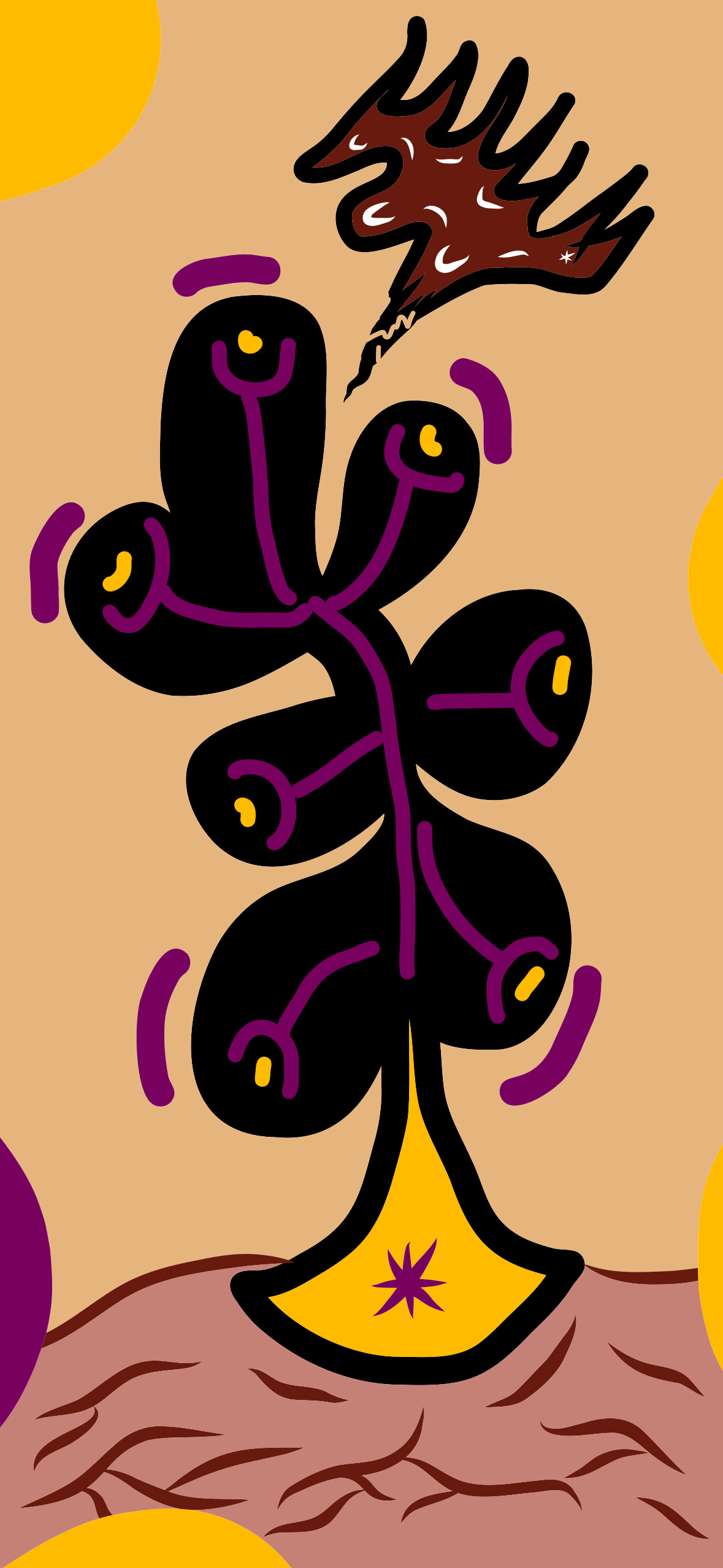The origin of the word amber in perfume is murky (pun somewhat intended). Perhaps it was to recall the amber color of an accord of labdanum & synthetic vanilla (called vanillin). Maybe it was a fantasy of what the real amber (the Jurassic stuff used in jewelry) smelled lik. Nonetheless when we smell amber, we know it. Let’s take a look at what amber means to me.
If Perfume was literature, ambers would be mythology. Tree resins are some of the oldest perfume materials in the world that we still use. No one knows how long ago they were first used – amber’s usage drifts quietly beyond antiquity where they were oft used in sacred rituals, incense, cleaning & medicine. Like myths, ambers connect us to an ancient sense of who we are and where we come from.
To me, an amber is a tree resin readily available for use with minimal processing. In the old days, ambers could simply be peeled off or tapped from trees. These days, they are oft filtered and treated for purity. Most ambers have sweet balsamic or vanillic aromas with overtones of flowers, woods, and spices. The following is my Amber Bible - these are the natural materials that I would consider ambers (there are plenty of aromachems with ambery qualities too, but that’s for later).
Baltic Amber
This is the true amber you find in jewelry & rock shops. The yellowy transparent fossilized tree sap that can have parts of antediluvian plants & insects perfectly preserved inside. This is extremely rare & almost never used in perfumery. It is not in the pallet of most perfume houses. Baltic amber is true fossilized amber dry distilled to release a syrupy oil that has a faint ashy smoke note & an otherworldly vibe like a quiet oud - musty, slightly cheesy - like a cave or a basement. I have only used it in one perfume I’ve released - 40 Million Year Old Amber - a super limited bottling that is a meditation & expansion on the quiet beauty of true fossilized Baltic Amber.
Benzoin
An amber of prime importance. Used in folk medicine for thousands of years, the extract of Styrax Tonkinensis (Siam Benzoin) is brown with soft pink notes of fine sugar, maple, powdery gourmand vanilla, and shades of cinnamon and dry tobacco. It blends well with coumarin, hay, grass notes (I use a ton in DSD’s COWBOY GRASS).
Cistus Labdanum
We call rock rose, a Mediterranean shrub, “cistus” when the whole plant is distilled or used in absolute extraction. The same plant produces a resin perfumers readily use called “labdanum” which is oft made into an absolute. I’ll discuss them separately as they are very different.
-Cistus Distilled
Cistus is one of the most prized top notes (which lasts into the heart) – a very rich, fancy, leathery, animalic amber. The herbaceous quality is less pronounced than when the same material is solvent extracted. Cistus oil has shades of floral honey and blends extremely well with all ambers. It has an almost mineral quality that recalls desert shrubs and even baking sand in the sun. Even small amounts can have a dramatic effect. It is very spicy, warm, and medicinal. If things get too sweet or fruity in an amber, balsam, or gourmand, cistus can bring you back to stasis. A very versatile material and key for chypres, spices, deep florals, and amber perfumes.
-Labdanum Resin/Absolute
This is the resin collected from Mediterranean rockrose (either from the plant itself or scrapped from the coats of sheep & goats that munch rockrose). Labdanum is spicy and herbaceous (with a dill note). Labdanum resin has a more animalic overtone than most other ambers. It displays a balsamic note not unlike some conifer species. It is essential in many famous perfume genres including chypre. It smells spicy and red and recalls old medicine and apothecaries as well as landscapes of dramatic rocks.
Copaiba Balsam
I’m fascinated with the idea of Occidental Ambers, as we often associate amber with the east. Since many balsamic and resinous trees thrive in tropical weather, we find plenty of these plants in the Caribbean, Central and South America. Many of these resins (Palo Santo, Guaiacwood, Cabreuva, Cascarilla) display woodier characteristics and would not necessarily be categorized as an “amber.” However, Copaiba Balsam distilled from the resin of the Copaifera Officinalus tree works as a “white amber” with its peppery dry musky aroma. Its clarity is the closest cousin of musk in the amber family. Copaiba Balsam’s versatility can give a warm woody slightly spicy fixation in the base of any genre of perfume. Copal is iconic in Mexico - you can sniff it burning all over the Yucatan peninsula.
Olibanum (frankincense) distilled/resinoid
Our generic term for burning perfumes “incense” comes for the common name for Olibanum: Frankincense (from various Boswellia plants in the family Burseraceae). Frankincense features heavily in ancient religion – Egyptian, Hebrew, Christian, Greek, and others. The bark of 10-year-old trees are cut, allowing the resin to bleed and form “tears.” These tears can be dissolved in a common solvent and used as a base note (producing a balsamic orange amber note) or distilled for a complex citrus-pine aroma in the top note section of a perfume.
Distilled incense with its dark peppery shade can imply smoke by association in the top of a fragrance. Its aroma is so baked into our consciousness from millenniums of use, that many people smell religion. It can imply deserts, shrubs, sand, temples, churches, and spiritual ceremonies. It can be used in a fantasy of embalming materials which is to say it has a natural medicinal throw. It is in fact medicine. I chew frankincense tears if I feel like I’m getting sick. African olibanum from Somalia & Kenya have a more lemon note than the Oman variety which has a definitive orange shade.
Olibanum resinoid is a vital fixative basenote that boldly harmonizes anything ambery. It smells old world – extending from old apothecary perfumes & Deco fantasies through the Middle Ages all the way back to antiquity. Frankincense probably has more associations related to it than any other perfume material. The orange character means that it can work in the base of citrus perfumes with ease. It is at home behind flowers – it has the ability to not overpower the base and make an idea a wearable perfume. If you said it smelled of smoked orange candy, you wouldn’t be wrong, but it is really so much more.
Elemi
Chock full of lemon smelling woody terpenes, elemi resin is as fresh as you can get in resin department. The aroma relates to the aroma of olibanum but with a much more yellow lemon-citric quality (as opposed to orange in the latter). Like copaiba balsam, it is very useful for its clear, clean fixation. Elemi can be detected in the top and heart as well. It is perfect in colognes or fresh fragrances. It can add interest to flower accords and help make transparent modern woody ambers or skin scents more natural smelling. Elemi has a medicinal quality (it is used in traditional medicine) that pairs well with herbs. The distillate make from the true oleorsin of elemi is exceedingly pure with a slight licorice gourmand note over its terpinic-lemon vibe.
Myrhh Oil/Absolute
Myrrh is the bitter-floral dry red scent of the desert. Myrrh’s scent is medicinal (being one of nature’s great medicines) and camphorous with a soft dirty (Earth) floral (indole - mothballs) undertone. It’s been holy since holy was a thing. It brings visions of camels, tents, & arid lands. I find the fragrance plays tricks – coming and going at different times on my skin. It has almost no sweetness, which is unique in this category. For this reason, I reach for myrhh to harmonize a perfume with lots of other amber materials (like DSD’s Amber Kiso).
Opoponax
Called Sweet Myrrh and sporting the coolest sounding name of all perfume materials, Opoponax is in the same family as myrrh (Burseraceae). It is stronger with complex lactonic buttery balsamic properties. It is an odd bird, quite gourmand for an amber – many of which are used in flavoring. It has subtle graham cracker sweetness, and a creamy licorice sheen that can stand in as the bitter backbone to flower accords. It is almost fresh, with a minty-camphorous angle for green, sport, and cologne aromas. It can make wood smell fine, lacquered and exotic. Opoponax is at home amount ambers and vanilla too. I would also say it smells more exotic than many ambers - like a fancy castle in an arid Eastern region of Hyperborea.
Pine Absolute
Pine Absolute is an emerald green sticky balsamic oil with a bitter almost alcoholic mushroom and wood scent. Good pine oil has a mushroom note (Matsutake Alcohol) which isn’t surprising as many mushrooms grow on decayed pine wood. Though pine is common, the absolute is less used than many other rare amber materials possibly due to its association with Yuletide or its deep green color. Pine Absolute is useful in conjuring the deep woods of deciduous and sub-arctic forests. It is the backbone of Amber Teutonic (one of my fave DSD’s released seasonally when the mood strikes).
Peru Balsam
Somewhere between Siam Benzoin and Tolu Balsam in strength and character, Balsam of Peru is spicy like cloves and cinnamon, gourmand like vanilla, but has a distinct woodiness absent in the other two ambers. It is quite gourmand, bringing images of gingerbread & dark spiced pastries, molasses & brown sugar.
Styrax
Also called Storax Amber, Styrax is often confused with Benzoin but is actually the resin of Liquidambar orientalis (what a name!) and sometimes is described as Levant Storax or Turkish Sweetgum. The resin of this tree is lighter in color and displays a smokier more animalic aromatic profile than true Benzoin. It is leathery, recalling wild animals - their skin & their funk. Styrax has a sootyness that recalls the smokestack, and chemical leatheriness that conjures the shoe store. Its cooler than most amber - in the James Dean kind of way. It smells badass.
Tolu Balsam
Aromatically a close cousin to Benzoin, Tolu Balsam is spicier & redder (cinnamon). It is heavy and powdery smelling of red potpourri. It is powerful and very gourmand. Too much & you get Big Red vibes. Compared to other workhorse ambers, tolu is thinner & fruiter, so I might use a touch in red fruits perfumes.
Vanilla Absolute
A true gourmand, and not a tree resin, but vanilla is very closely associated with the amber category. It is penetrating and powerful. Vanilla absolute is the jasmine of base notes – a touch makes something smell like “perfume” with old world elegance. Global warming, demand and weather have destroyed many of the crops of this particularly labor-intensive plant product, making it extremely expensive. Most vanilla flavoring comes from synthetic vanillin, which is useful in its own right but lacks the elegant depth of the real absolute. Vanilla absolute is dark & smoky (I made Deep Dark Vanilla as an expansion upon this OG). Desert island material.
Thanks for reading my ever continuing Amber Bible! There are more resins out there. Even more materials with amber qualities. But the above the most important ambers in my perfume organ.






Thanks for the detailed Amber Bible! Your descriptions are exquisite and intricate. A delight to my senses. I especially liked your comment at the outset: "If Perfume was literature, amber would be mythology." Spoken like a true synesthete!
styrax IS badass! i'm so curious which molecules are responsible for that edgy industrial-smelling vibe